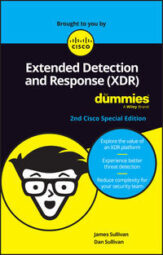Extended Detection and Response (XDR) For Dummies, 2nd Cisco Special Edition
Download E-BookHere are ten things you need to know about XDR including some key features to look for when shopping for an XDR solution.
Reduce time to detect and respond
At the end of the day, XDR platforms aim to reduce detection and response times. More data and more tools don’t mean faster security teams. They often mean overwhelmed security teams. XDR focuses on providing actionable information through machine learning-supported analytics and a centralized dashboard. On the response side, orchestration and automation features streamline the response process by providing easy-to-use and customizable tools for security staff.Visualize integrated security data
XDR takes in a lot of information and must organize it to reduce alert fatigue, false positives, and general security operations hassle. Central dashboards are customizable information hubs for security teams to organize their data to fit the organization’s needs. Visualization tools such as incident maps should help identify threat sources and trace potentially new attack points.Precise monitoring
Because XDR platforms usually come with machine learning-based analytics, and rely on secondary security tools for data collection, security teams should have a clear view of an organization’s ecosystem. Providing good information, rather than lots of information, cleans up what staff actually see, making it easier to focus on legitimate security concerns.Contextualize alerts and reduce false positives
XDR’s centralized dashboard features provide context to security situations. Alerts coming in are more reliable because the XDR system has the relevant threat intelligence required to make decisions about what is concerning, abnormal behavior and what isn’t.False positives are a waste of resources, and XDR’s comprehensive view of the IT infrastructure helps reduce their frequency.
Automated responses
Automation features have been around in the security space for some time, but XDR’s broad reach enables its automation tools to benefit from some fine-tuning. Many XDR products offer machine learning-supported automation that can take care of rote security tasks, so security staff can work on the harder jobs that need human intervention.Keep it open
XDR isn’t a lone wolf and needs the support of specialized security tools. XDR platforms offer a lot of integration options, both with existing security tools and ones that may be added in the future.Endpoint detection and response (EDR) and network detection and response (NDR) in particular are two tools to think about including when building out your security infrastructure.


